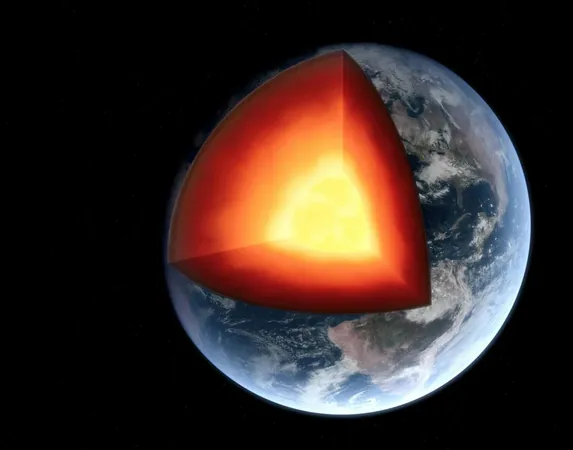
Why Is Earth's Core as Hot as the Sun's Surface? Unraveling the Mystery!
2025-08-03
Author: John Tan
A Fiery Secret Beneath Our Feet
Have you ever wondered how the Earth's core can stay infinitely hot, comparable to the surface of the Sun, for billions of years? Buckle up! This isn't just a science lesson—it's a deep exploration into our planet's fiery heart.
A Layered Marvel: The Earth's Structure
Imagine peeling back the layers of an onion—that’s akin to what the Earth looks like beneath our feet! The outer crust, where we roam, is just a thin shell above several powerful layers. Below the crust lies the mantle, a mostly solid rock layer, followed by the liquid outer core made of molten iron, and finally, the solid inner core composes mainly of iron.
Mapping the Unseen
Scientists dive deep into Earth's mysteries using seismic waves, akin to ultrasound used in medicine. These sound waves generated by earthquakes provide crucial insights into Earth's internal structures. The crust can plunge up to 20 miles (30 kilometers) down, revealing all sorts of geological wonders!
Earth's Moving Puzzle Pieces
The Earth's lithosphere, which includes the crust and upper mantle, moves like giant puzzle pieces known as tectonic plates. These plates drift slowly but can cause earthquakes and volcanoes when they collide or separate. This activity doesn’t just create geography; it plays a vital role in the evolution of life itself!
Unveiling The Heat Within
As we journey deeper towards the core, temperatures skyrocket. At depths around 60 miles (100 kilometers), it can reach 2,400°F (1,300°C). Plunge further down to the outer core boundary, and the heat surges to almost 5,000°F (2,700°C). By the time we reach the inner core, we're talking about astounding temperatures of nearly 10,800°F (over 6,000°C)—that’s literally on par with the Sun!
Where Does This Heat Come From?
Interestingly, this intense heat isn't a gift from the Sun! Instead, it stems from two main sources. First, Earth retains heat from its violent formation 4.5 billion years ago when countless planetary collisions caused an explosion of thermal energy. Second, radioactive isotopes like uranium and thorium continuously release energy as they decay, keeping the inner Earth toasty.
A Heat-Driven Dance of Plates
The relentless heat from the core and mantle fuels plate motion, essential for shaping our planet's surface. Without this heat, the tectonic plates would stall, Earth would cool down, and life as we know it might not even exist!
Reflecting on the Earth's Lifeblood
As you ponder these fiery phenomena, remember the crucial role Earth's internal heat plays. It shapes landscapes, creates oceans, and influences our atmosphere over eons. Next time you feel the ground beneath your feet, think of the seething energy that keeps our planet alive and thriving!


 Brasil (PT)
Brasil (PT)
 Canada (EN)
Canada (EN)
 Chile (ES)
Chile (ES)
 Česko (CS)
Česko (CS)
 대한민국 (KO)
대한민국 (KO)
 España (ES)
España (ES)
 France (FR)
France (FR)
 Hong Kong (EN)
Hong Kong (EN)
 Italia (IT)
Italia (IT)
 日本 (JA)
日本 (JA)
 Magyarország (HU)
Magyarország (HU)
 Norge (NO)
Norge (NO)
 Polska (PL)
Polska (PL)
 Schweiz (DE)
Schweiz (DE)
 Singapore (EN)
Singapore (EN)
 Sverige (SV)
Sverige (SV)
 Suomi (FI)
Suomi (FI)
 Türkiye (TR)
Türkiye (TR)
 الإمارات العربية المتحدة (AR)
الإمارات العربية المتحدة (AR)